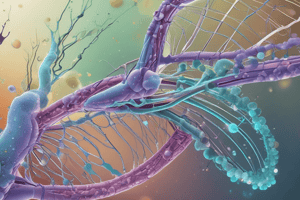Podcast
Questions and Answers
Which initiation factor helps to recruit the small subunit to the mRNA during eukaryotic translation initiation?
Which initiation factor helps to recruit the small subunit to the mRNA during eukaryotic translation initiation?
- eIF1
- eIF1A (correct)
- eIF4
- eIF2
What is the primary function of ribosome profiling?
What is the primary function of ribosome profiling?
- To determine the position of ribosomes on mRNAs (correct)
- To study the structure of ribosomes
- To analyze the sequence of mRNAs
- To synthesize proteins in vitro
What is the main function of the UPF1 protein in the Nonsense-mediated Decay pathway?
What is the main function of the UPF1 protein in the Nonsense-mediated Decay pathway?
- To phosphorylate UPF1 and trigger the degradation pathway
- To bind to the exon junction complex and help recruit the degradation machinery
- To recruit the degradation machinery to the ribosome
- To bind to the ribosome and scan the mRNA for premature stop codons (correct)
How do microRNAs inhibit translation elongation?
How do microRNAs inhibit translation elongation?
What is the function of mRNA zipcodes in mRNA localization?
What is the function of mRNA zipcodes in mRNA localization?
Which of the following is NOT a key mechanism of mRNA localization?
Which of the following is NOT a key mechanism of mRNA localization?
Study Notes
Initiation Factors
- Eukaryotic translation initiation is a complex process involving multiple initiation factors (eIFs)
- These factors bind to the small subunit of the ribosome, mRNA, and other factors to facilitate translation initiation
- Key initiation factors:
- eIF1: binds to the small subunit of the ribosome and prevents premature binding of mRNA
- eIF1A: helps to recruit the small subunit to the mRNA
- eIF2: binds to the initiator methionyl-tRNA and GTP, and directs the ribosome to the start codon
- eIF3: binds to the small subunit and mRNA, and helps to recruit the 60S ribosomal subunit
- eIF4: binds to the mRNA cap and helps to recruit the small subunit
- eIF5: helps to join the small and large subunits of the ribosome
Ribosome Profiling
- Ribosome profiling is a technique used to study translation in vivo
- It involves the sequencing of ribosome-protected mRNA fragments to determine the position of ribosomes on mRNAs
- Provides information on:
- Translation initiation and elongation rates
- Ribosome occupancy and density
- Translation efficiency and accuracy
- Identification of novel open reading frames (ORFs)
Nonsense-mediated Decay
- Nonsense-mediated decay (NMD) is a surveillance pathway that degrades mRNAs containing premature stop codons
- Helps to prevent the production of truncated proteins that could be toxic to the cell
- Key components of the NMD pathway:
- UPF1: a helicase that binds to the ribosome and scans the mRNA for premature stop codons
- UPF2: a protein that binds to UPF1 and helps to recruit the degradation machinery
- UPF3: a protein that binds to the exon junction complex and helps to recruit the degradation machinery
- SMG1: a protein kinase that phosphorylates UPF1 and triggers the degradation pathway
MicroRNA Regulation
- MicroRNAs (miRNAs) are small non-coding RNAs that regulate gene expression by binding to target mRNAs
- miRNAs inhibit translation by:
- Blocking the initiation of translation
- Inducing the degradation of target mRNAs
- Inhibiting the translation elongation step
- Key components of the miRNA pathway:
- Dicer: an enzyme that cleaves precursor miRNAs to generate mature miRNAs
- Argonaute: a protein that binds to miRNAs and targets mRNAs for degradation or translation inhibition
mRNA Localization
- mRNA localization is the process of targeting specific mRNAs to specific regions of the cell
- Helps to regulate protein synthesis and activity in response to local cues
- Key mechanisms of mRNA localization:
- mRNA zipcodes: specific sequences in the mRNA that are recognized by RNA-binding proteins
- RNA-binding proteins: proteins that bind to mRNA zipcodes and direct the mRNA to specific locations
- Microtubules and motor proteins: help to transport mRNAs to specific locations
- Localization elements: specific sequences in the mRNA that are recognized by the localization machinery
Studying That Suits You
Use AI to generate personalized quizzes and flashcards to suit your learning preferences.
Description
This quiz covers the processes of translation initiation, ribosome profiling, and mRNA regulation in eukaryotic cells. It includes topics such as initiation factors, nonsense-mediated decay, microRNA regulation, and mRNA localization. Test your knowledge of these fundamental biological processes!




